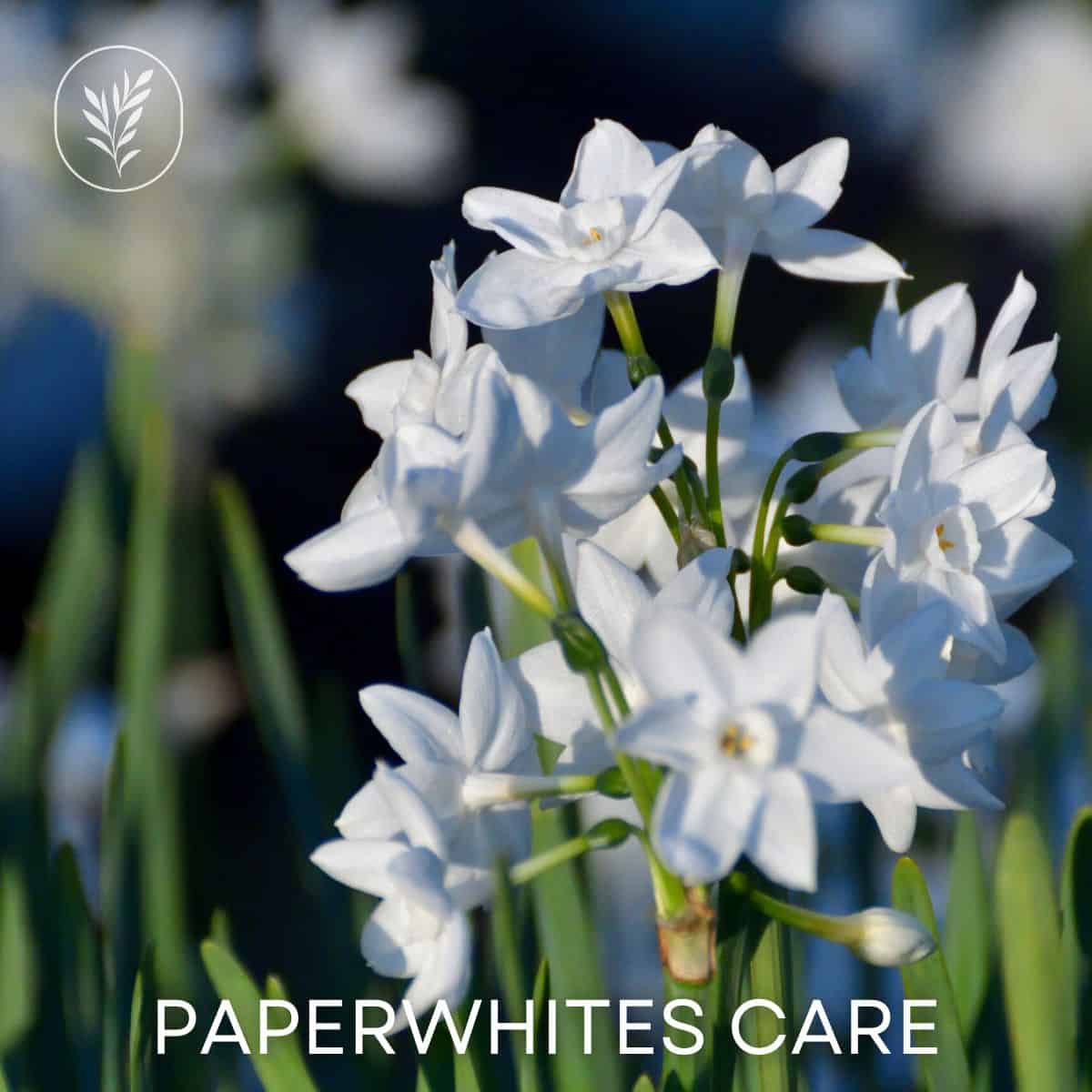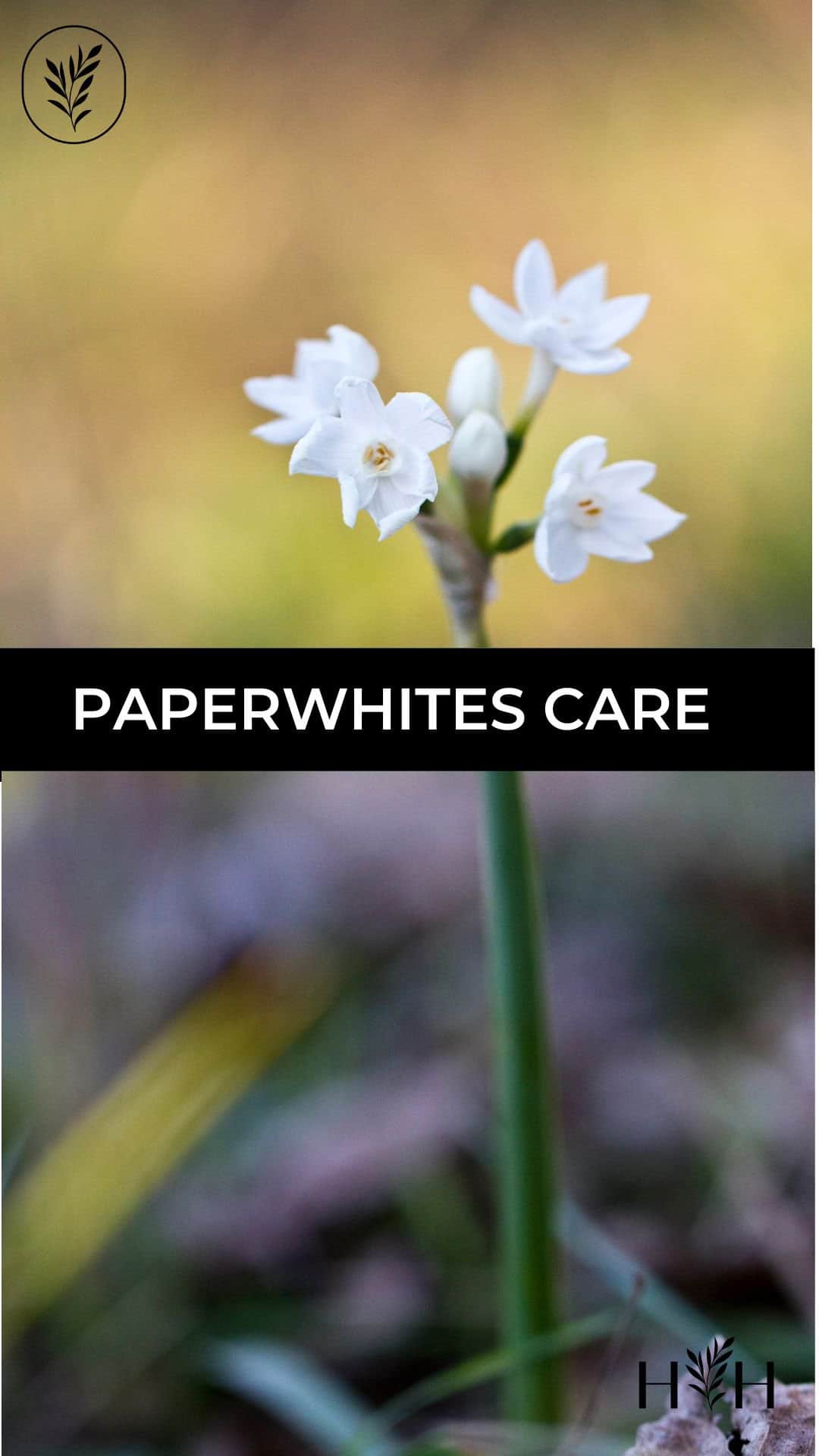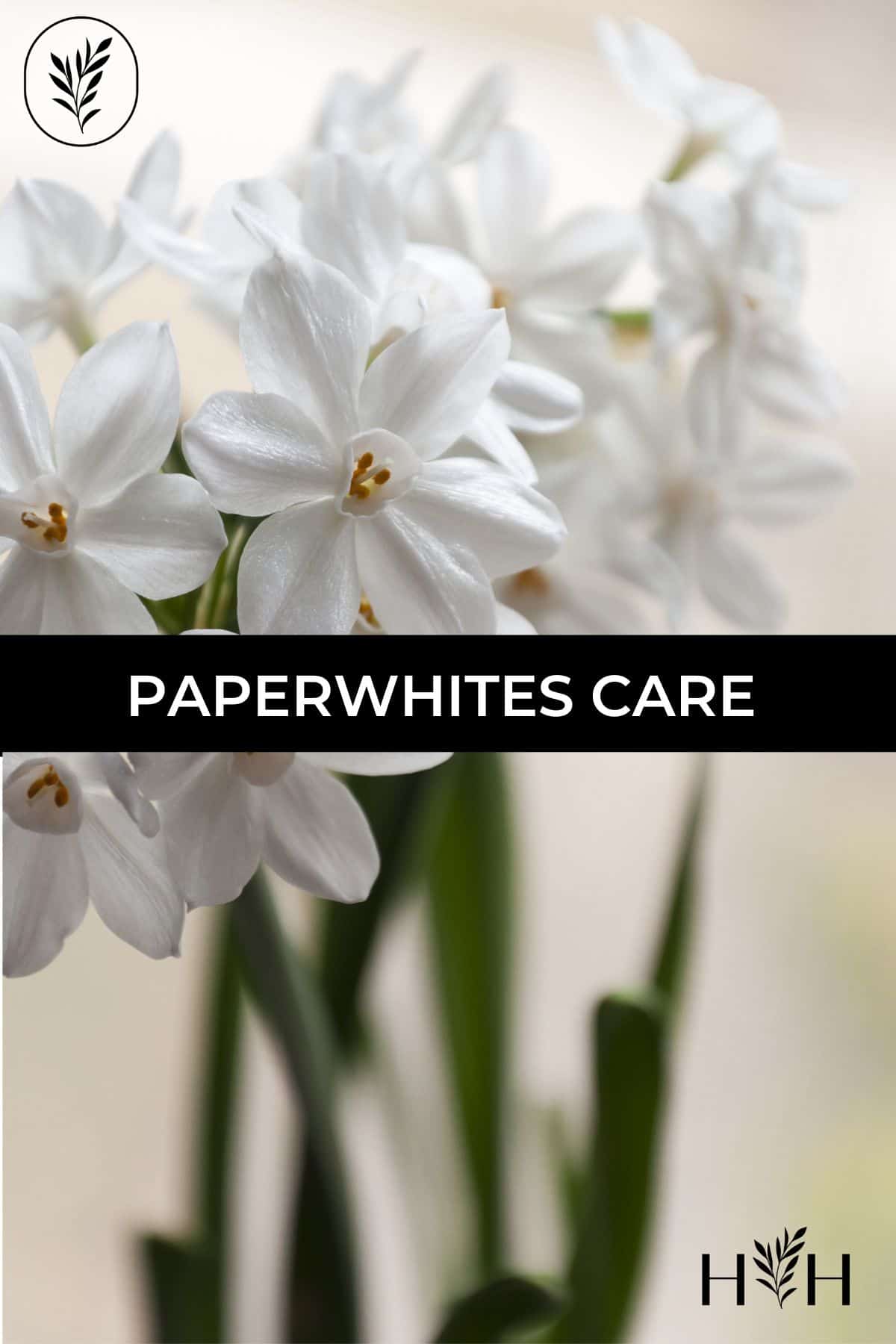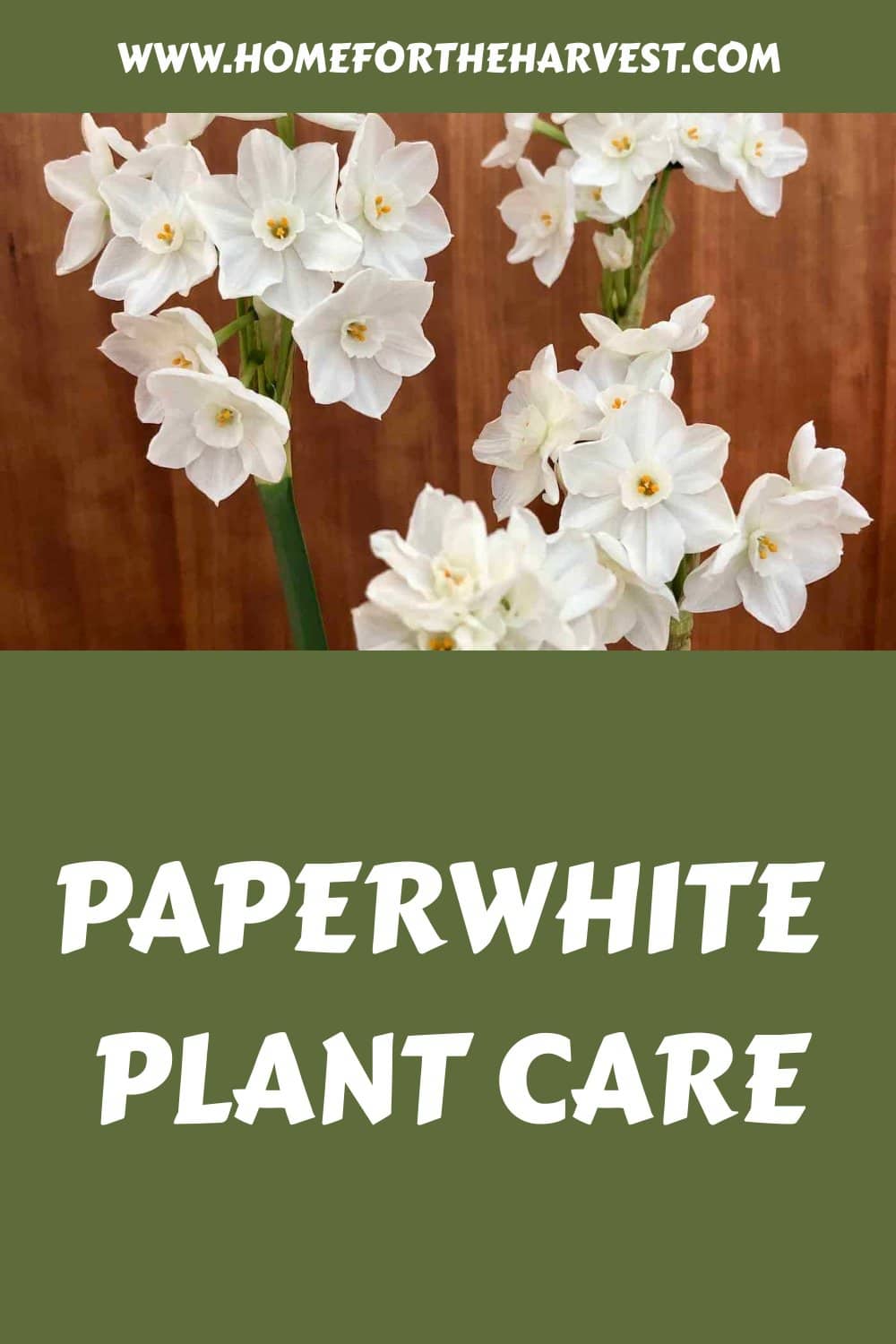Paperwhites are one of the most popular flowering plants to grow indoors during the winter. Fortunately, these blooming bulbs are very easy to care for!
Paperwhite care includes giving the planted bulbs access to water without letting the entire bulb sit in a moist environment (as this often causes rot). Care also includes moving the Paperwhite plant into a bright area such as a sunny windowsill as the sprouts start to develop. Some gardeners also like to pickle their Paperwhite bulbs to reduce the plant’s height or to add decorative flower stakes or ribbons to hold up foliage that flops over.
Read on to learn all about Paperwhite care!
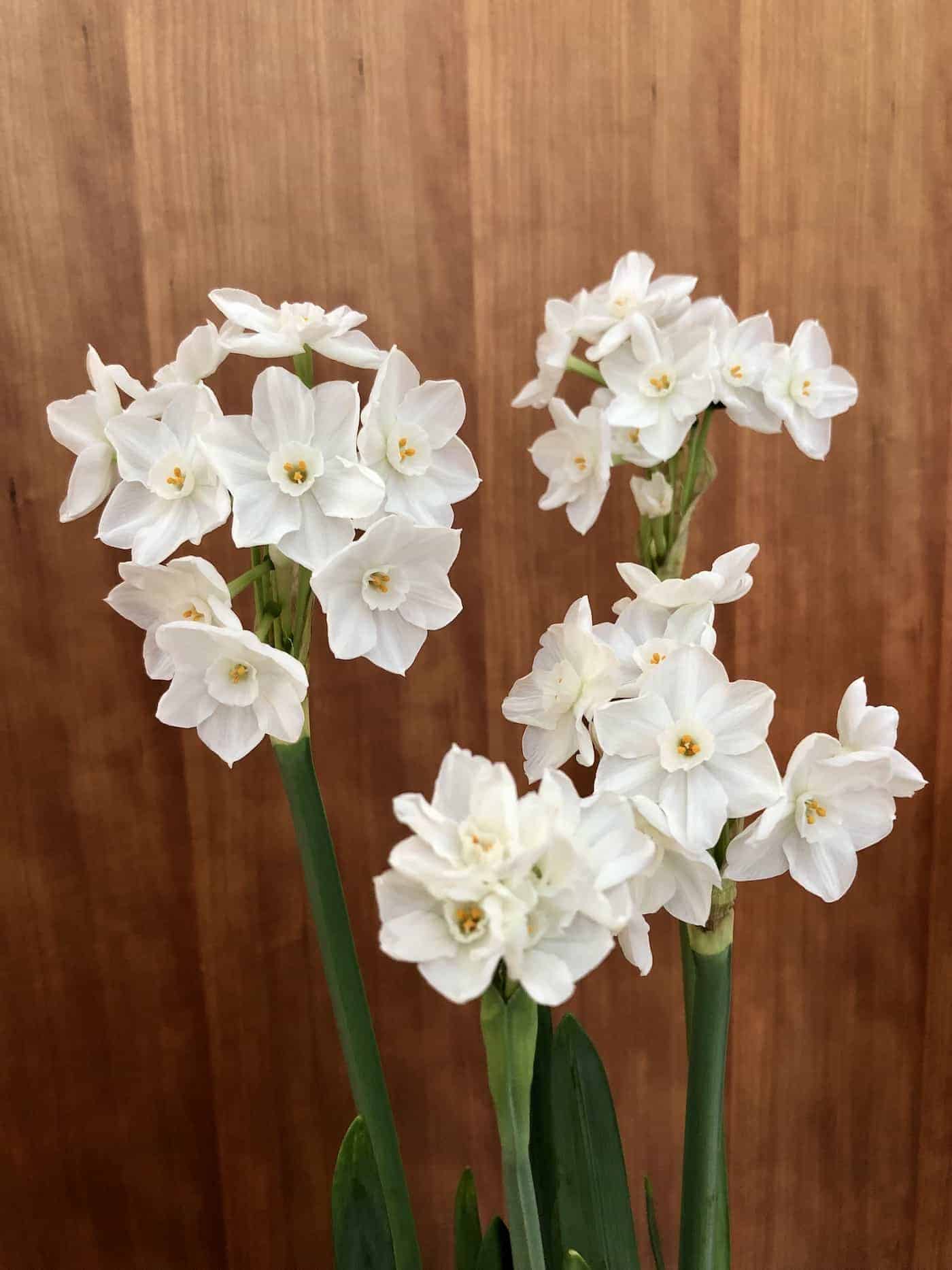
Paperwhites: Care basics
The Paperwhite Flower is among the easiest indoor flowering plants to care for. Taking care of Paperwhites is even easier than planting Paperwhite bulbs!
Newly-planted Paperwhite bulbs are best kept in a cool spot indoors out of direct sunlight. The ideal temperature for sprouting bulbs is in the range of 50°-60°F (10°-16°C), but these bulbs will sprout just fine at room temperature. Paperwhites can be moved to a warmer spot near a sunny window as soon as the roots and stems start to grow.
While growing Paperwhites are tolerant of warmth, try to keep them somewhere where they’ll remain below 70°F (21°C), as they can grow very tall in warm temperatures. Paperwhites forced in cooler temperatures (60°-65°F,16°-18°C) tend to grow stronger, stockier stems (making them less likely to fall over).
Ensure the base of the bulbs is moist as the roots start to form. Paperwhite bulbs planted in water alone should barely touch the surface of the water. Once the roots are growing downwards, the water level should be lowered to below the bulb itself, with only the roots dangling into the water. Paperwhites growing in potting mix should be watered whenever the top inch of soil becomes dry.
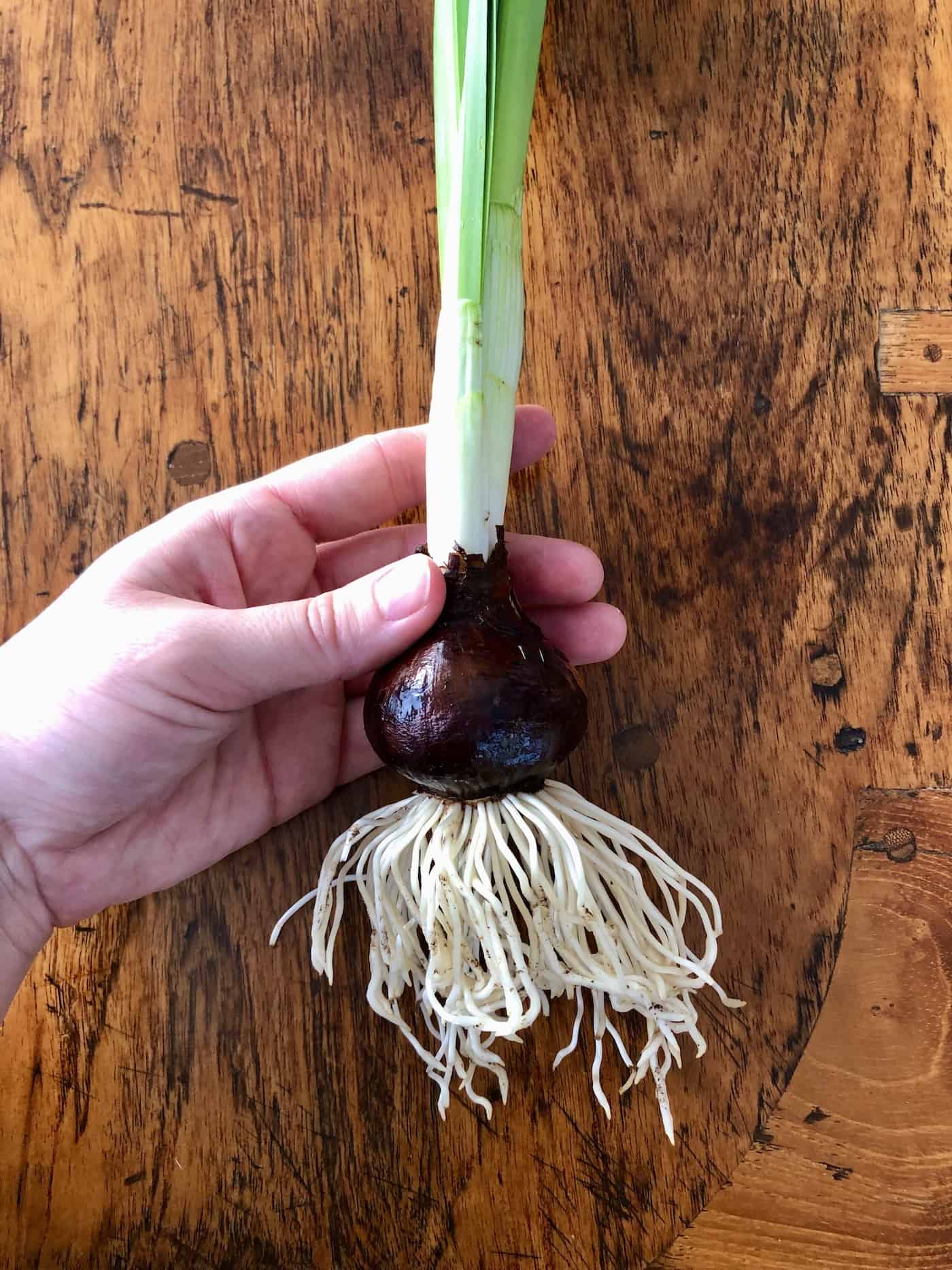
Watering Paperwhites
Paperwhite bulbs are generally watered several times per week. Watering frequency will increase in homes with dry air and for Paperwhites grown in water, as the water level must be kept consistent.
Paperwhites grown in water or in pebbles should barely be touching the surface of the water when first planted. As soon as downward-growing roots are visible, decrease the water level so that the bulb is not sitting in the water. Only the roots should extend down into the water reservoir.
Newly-planted Paperwhites grown in a potting mix can be watered whenever the top inch of the potting mix is dry. Actively growing Paperwhites consume quite a bit of moisture and should be checked daily to ensure they are getting enough water.
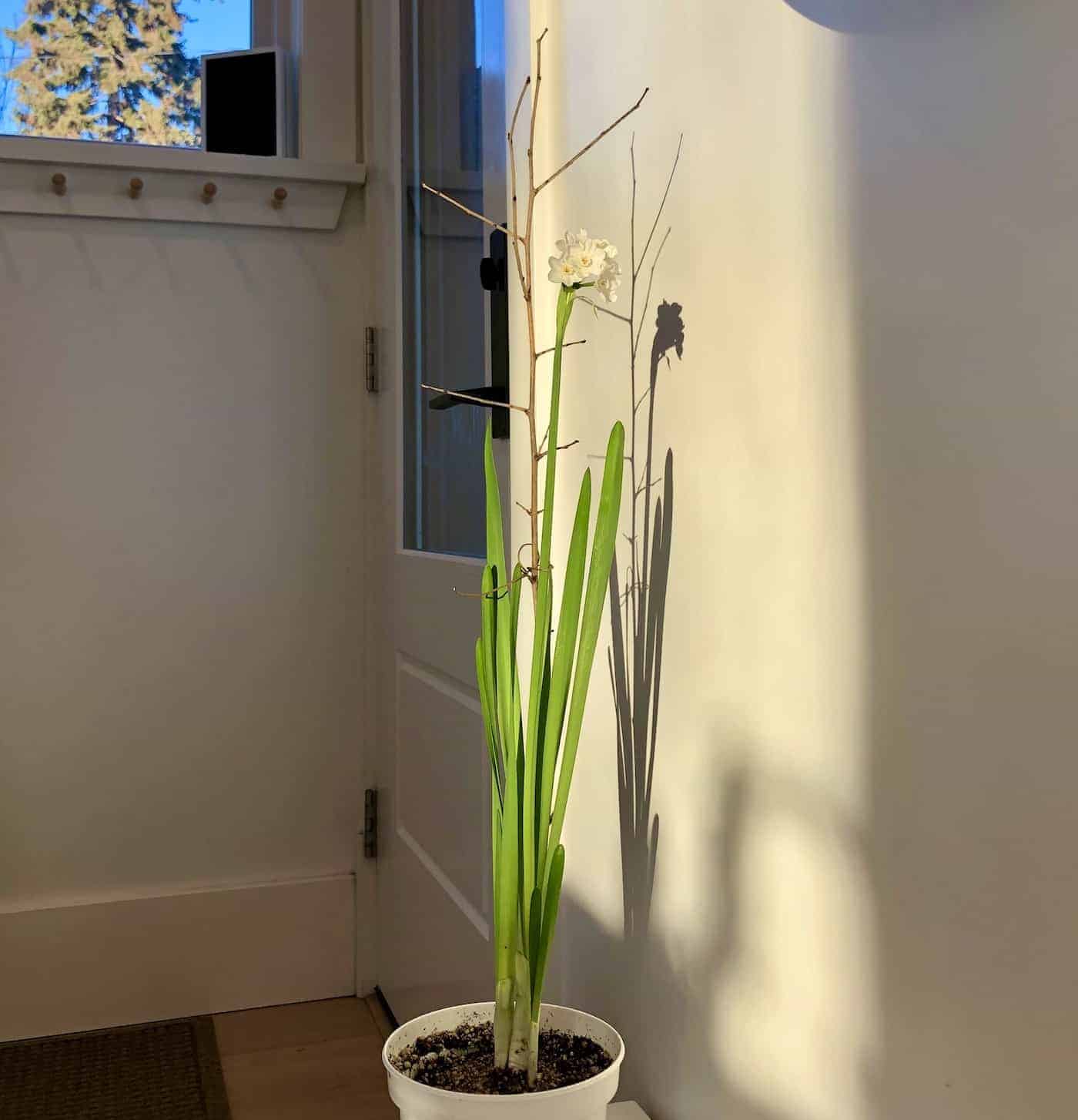
Light requirements for Paperwhites
Check the bulbs frequently for signs of growth, including root development and the start of green shoots. This process usually takes a couple of weeks.
Once growing roots are visible, move the Paperwhites to a bright, warm location such as a sunny spot on a windowsill or under a plant light. Direct sunlight (or artificial bright light) is preferable at this point to promote photosynthesis.
Once blossoms appear, the plant can be moved out of direct sunlight to help the flowers last longer. Read more about forcing Paperwhites for extra details.
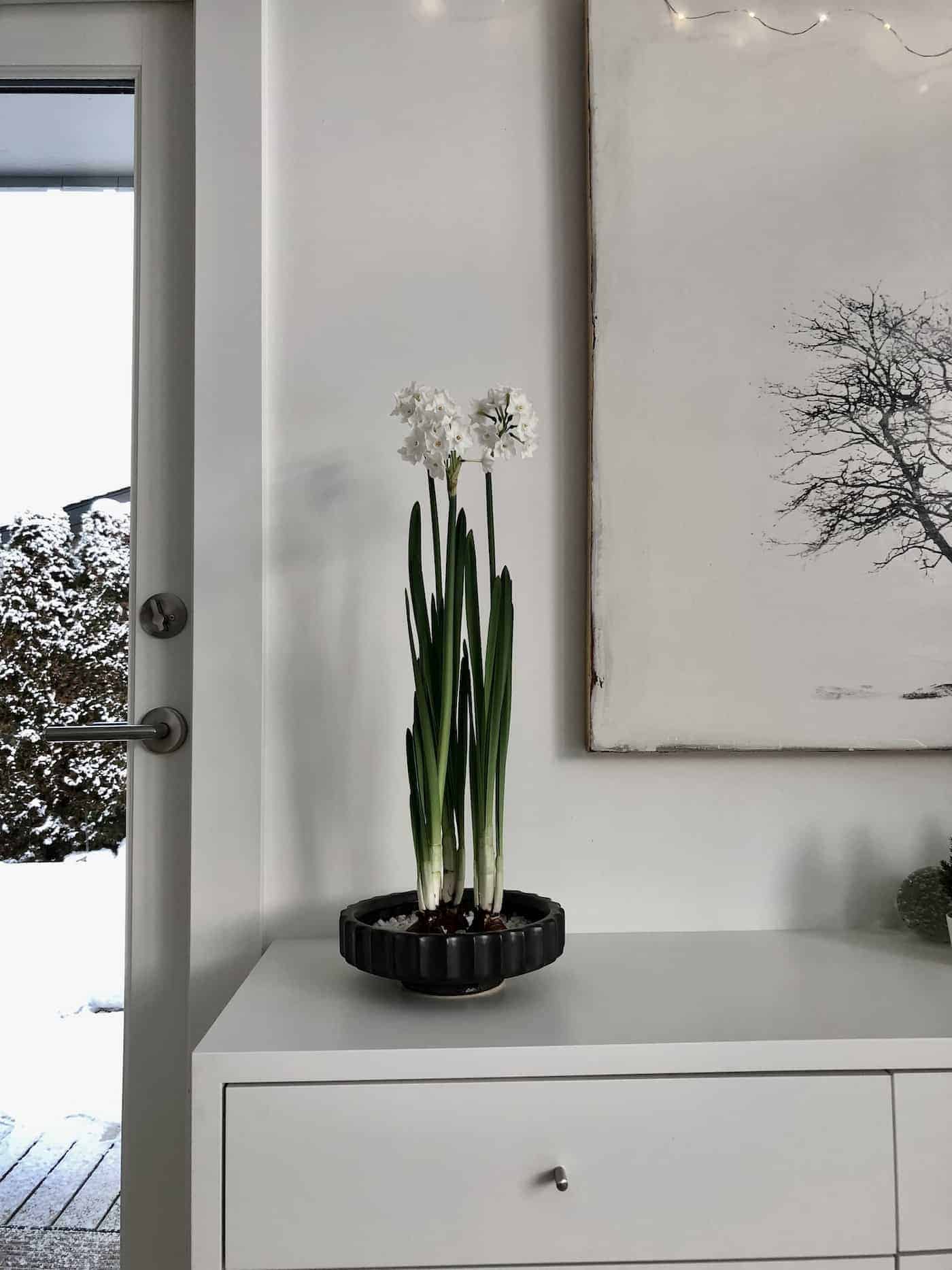
What to do with Paperwhites after they bloom?
Most gardeners discard Paperwhites after they bloom. Paperwhite bulbs are quite weak after they bloom indoors. Filtered indoor light does not provide the sunlight levels required for the plants to photosynthesize enough stored energy to grow a flower bud inside the bulb for the next year. Even when dormant storage is optimal, Paperwhites generally won’t bloom the following year after blooming indoors.
Paperwhite bulbs can only be reused when planted outdoors in warm areas. Paperwhites that have bloomed indoors and are then planted outdoors in warm climates likely will not bloom for a couple of years, as the bulbs will need a season or two to build up enough stored energy to set a flower bud.
Paperwhites grown outdoors will only come back every year in warm climate areas in Zones 8-11. In Zones 7 and colder, Paperwhite bulbs will not generally survive cold winter temperatures in these regions. Gardeners in Zones 7 and colder generally toss Paperwhite bulbs into the compost after they bloom.
“When you paper whites are finished blooming, throw them away whether you like the scent or not. The reasons? 1) Because paper whites are not winter hardy, they’ll turn to mush in most temperate zone gardens, and 2) you can’t force them two years in a row since forcing this type of bulb weakens it.”
Bulb Forcing for Beginners and the Seriously Smitten, by Art Wolk
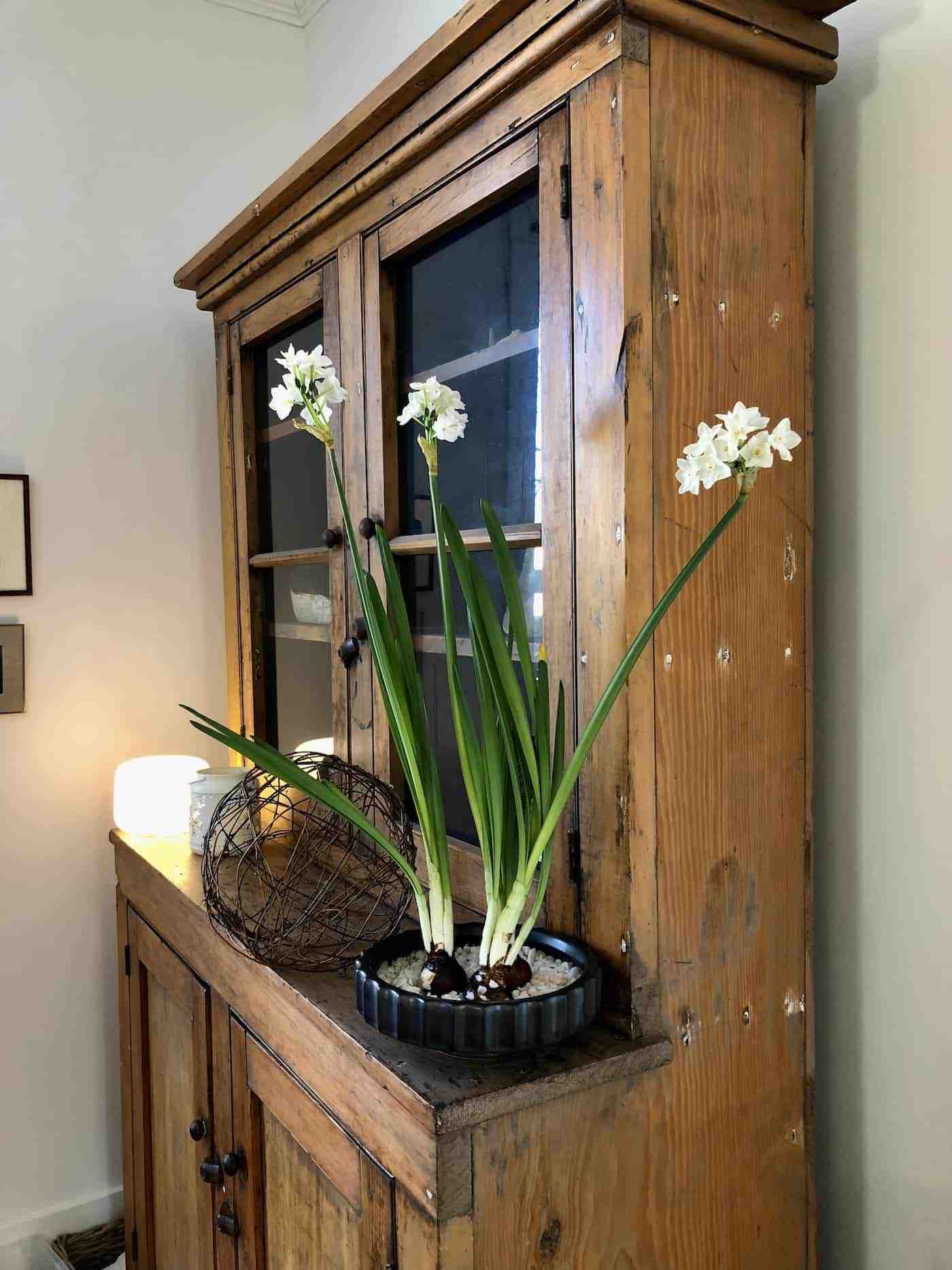
Problems when caring for Paperwhites
One of the most common plant care complaints with Paperwhite flowers is that the leaves tend to flop over while the plants are in bloom. If your Paperwhites are falling over, use sticks to make tiny plant stakes or tie a wide ribbon around all the stems and foliage. If using the same brand of bulbs in future years, consider growing Paperwhites inside a tall glass vase or stunting their growth with an alcohol solution (see below).
Pickling Paperwhites to stunt height
“Pickling” paperwhites with a solution of diluted alcohol is a common method of shortening the height of Paperwhite plants. The shorter stems are easier to display and less likely to flop over. Pickling is generally done with paperwhites grown in water or planted in pebbles (or another soil-less media).
The idea is to water newly sprouting bulbs with a ~5% alcohol solution for about a week before the plants get too tall. This usually reduces the mature height by about 1/3 of the expected height (source: Cornell University). Instead of 16″-18″ tall Paperwhites, you get plants that are only about 12″ tall.
Start the bulbs off with plain fresh water. About a week after planting, look for signs of growth (roots and stems). Once the green stem is 1″-2″ tall, empty out the plain water and then use the alcohol solution instead. Paperwhite plants can be watered with the dilute alcohol solution until they start to flower.
You can make the dilute alcohol solution with rubbing alcohol or clear liquor spirits like vodka or gin. The solution should be approximately 5% alcohol. If using a 40%-alcohol distilled spirit, use 1 part of the spirit with 7 parts water. So to make 2 cups of solution, mix 1 ¾ cups of water with ¼ cup of 40% liquor. Do not use sugar-containing alcohols like beer or wine, and do not exceed 10% alcohol in the solution.
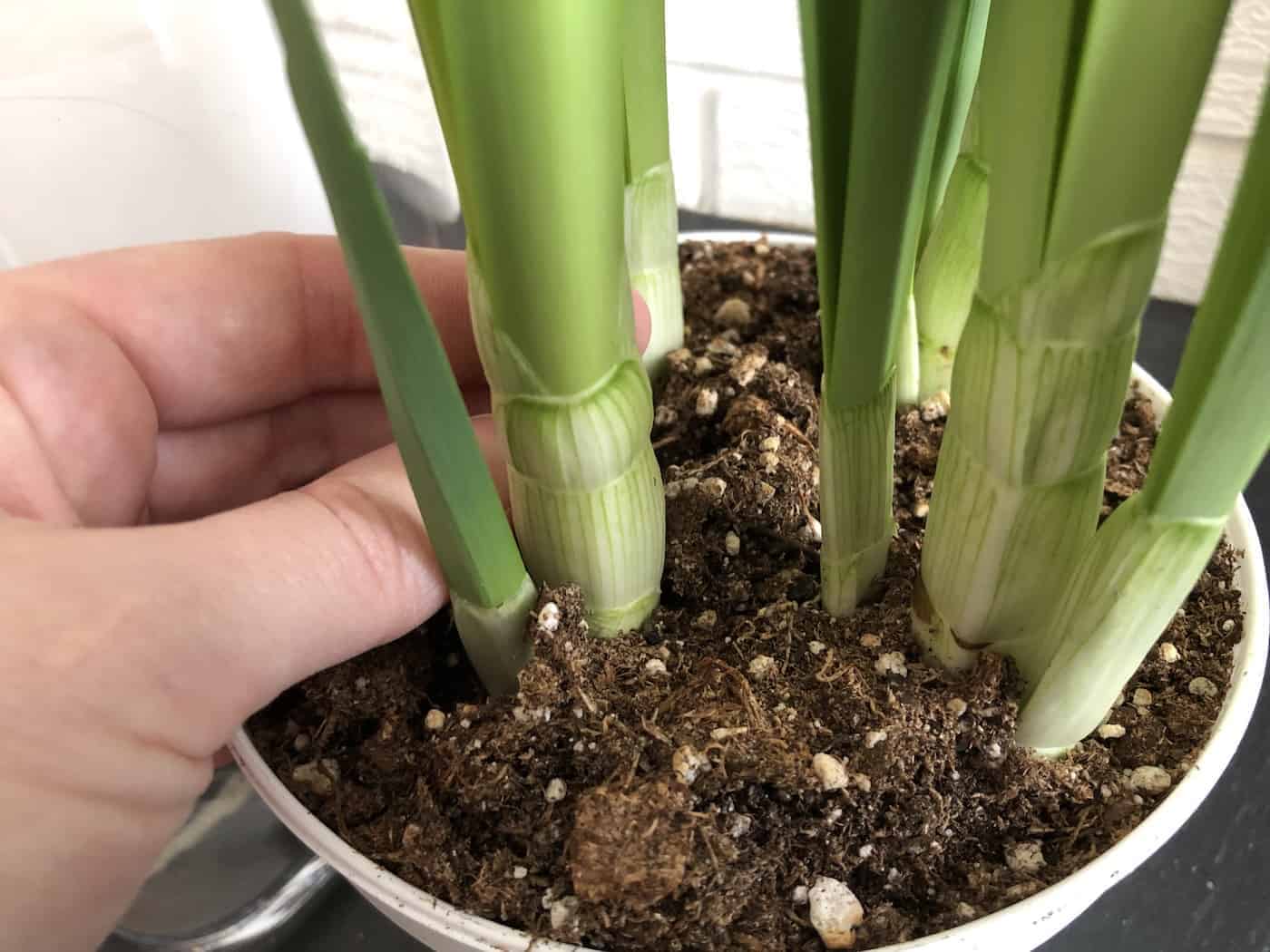
FAQs
What do you do with paperwhite bulbs after they bloom?
Most gardeners discard Paperwhites after they bloom because the bulbs are quite weak after they bloom indoors. Paperwhite bulbs can only be reused when planted outdoors in warm areas.
Do paperwhites come back every year?
Paperwhites that have bloomed indoors and are then planted outdoors in warm climates likely will not bloom for a couple of years, as the bulbs will need a season or two to build up enough stored energy to set a flower bud. Paperwhites grown outdoors will only come back every year in warm climate areas in Zones 8-11.
How long do paperwhites last indoors?
Paperwhite blooms will last for a few weeks indoors.
Can paperwhite bulbs be planted outside?
Paperwhites can be grown as perennials in warm climate areas in Zones 8-11.
Resources
- Paperwhite Flower: A Lovely Indoor Winter Bloomer
- Joyful Dirt Organic Houseplant Fertilizer
- My Favorite Tools For Caring For Houseplants
- Houseplant Propagation Guides
- Want garden tips, updates, and freebies? Sign up for my newsletter
- My favorite things for houseplants
- Visit My Shop
References
- Bulb Forcing for Beginners and the Seriously Smitten, by Art Wolk
More houseplant articles
Paperwhites are beautiful white flowers that bloom indoors in the winter… But they’re just one of the many beautiful houseplants we’ve written about! Click the box below for more articles.


